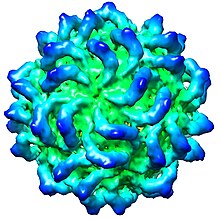Partitiviridae
| Partitiviridae | |
|---|---|
 |
|
| CryoEM reconstruction of Penicillium stoloniferum virus S capsid, a partitivirus. EMDB entry EMD-5161 | |
| Virus classification | |
| Group: | Group III (dsRNA) |
| Order: | Unassigned |
| Family: | Partitiviridae |
| Genera | |
Partitiviridae is a family of viruses. Fungi and plants serve as natural hosts. There are currently 56 species in this family, divided among 5 genera. Their name comes from the Latin partitius which means divided and they are called this as they have segmented genomes.
Viruses in Partitiviridae are non-enveloped, with icosahedral geometries, and T=1 symmetry. The diameter is around 35-40 nm. Partitiviruses have double stranded RNA genomes divided into two genomic segments and there may be additional subgenomic segments. The genome segments are packaged in the same virus particle, the larger segment codes for the RNA-dependent RNA polymerase and the smaller codes for the coat protein. Genomes are linear and around 1.4-3.0kb in length. The genome codes for 2 proteins.
Viral replication is cytoplasmic. Entry into the host cell is achieved by penetration into the host cell. Replication follows the double-stranded RNA virus replication model. Double-stranded RNA virus transcription is the method of transcription. The virus exits the host cell by cell-to-cell movement. Fungi and plants serve as the natural host.
There are currently five recognized genera within the Partitiviridae family:
Group: dsRNA
Cryspoviruses infect apicomplexian protozoa of the genus Cryptosporidium, while viruses of the other genera infect plants and fungi. There are an additional fifteen species in the family unassigned to a genus.
Based on the RNA polymerase gene this group can be divided into four clades (I-IV). Four isolates from animals and protozoans form a fifth clade. Clades I-IV consist of mixtures of partitivirus-like sequences from plants and fungi.
...
Wikipedia
